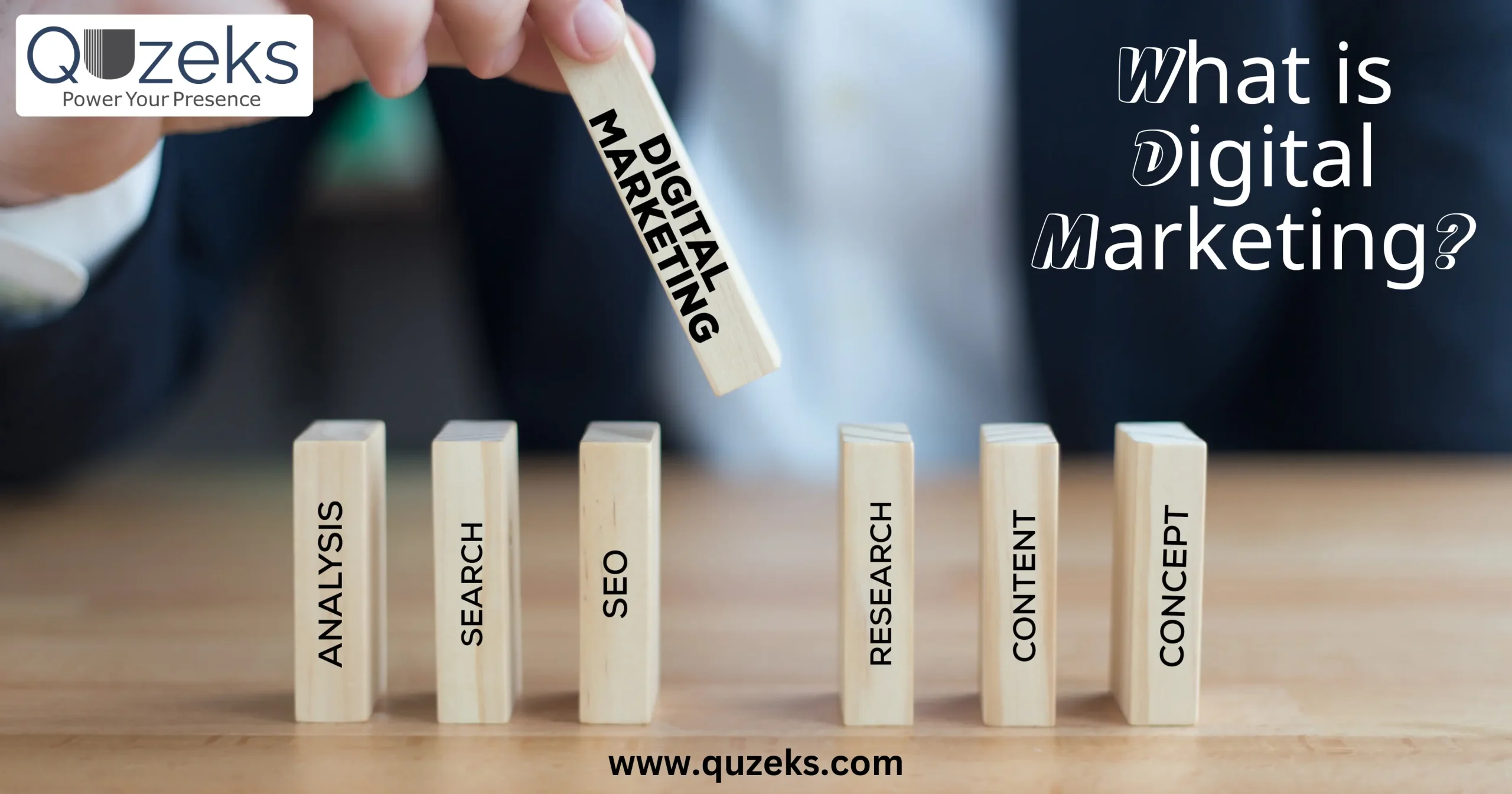- In the digital era, understanding the shades of digital marketing in the online realm is paramount for businesses aiming to thrive.
- In today’s digital age, businesses must adapt and embrace the power of online channels to reach their target audience effectively.
- Digital marketing has emerged as a cornerstone strategy for businesses to promote their products or services, engage with customers, and drive revenue growth.
- It encompasses a spectrum of strategies and channels, each playing a vital role in reaching and engaging with target audiences.
What is Digital Marketing?
- Digital marketing means using the internet and technology to promote brands, products, or services through online channels.
- These channels include websites, search engines, social media platforms, email, mobile apps, and more.
- Unlike traditional marketing methods, digital marketing leverages the internet and digital technologies.
- It connect with potential customers in real-time, track performance metrics, and optimize campaigns for better results.
Key Component of Digital Marketing:
In today’s digital era, marketing has taken on a new form, leveraging the power of the internet to connect with audiences and promote products or services. Let’s dive into the basics of digital marketing, focusing on key strategies and tactics that businesses can use to reach their target audience effectively.
Social Media Marketing:
- Social media marketing involves using platforms like Facebook, Instagram, and Twitter to connect with customers and promote your brand.
- By sharing engaging content, interacting with followers, and running ads, businesses can effectively increase brand awareness and drive engagement.
Example: A local coffee shop shares photos of their delicious drinks on Instagram to attract customers and promote their unique offerings.
Search Engine Optimization (SEO):
- SEO is about making your website more visible on search engines like Google.
- Using the right keywords and improving your website’s structure, you can rank higher in search results and attract more organic traffic.
Example: A bakery uses keywords like “freshly baked pastries” to optimize their website and attract customers searching for delicious treats in their area.
Search Engine Marketing (SEM):
- SEM involves using paid advertising to appear at the top of search results.
- Additionally, by strategically bidding on keywords, businesses can drive targeted traffic to their website and increase conversions.
Example: A software company runs Google Ads campaigns to promote their products and reach customers searching for software solutions.
Pay-Per-Click (PPC) Advertising:
- PPC advertising allows businesses to display ads online and pay only when someone clicks on them.
- It’s a cost-effective way to drive targeted traffic to your website and increase sales.
Example: A travel agency creates PPC ads to promote vacation packages and attract customers searching for travel deals.
Affiliate Marketing:
- Affiliate marketing involves partnering with influencers or other businesses to promote your products or services.
- By offering a commission for each sale generated, businesses can expand their reach and increase sales.
Example: A fashion brand collaborates with influencers to showcase their latest clothing line and attract new customers.
Content Marketing:
- Content marketing focuses on creating valuable content to attract and retain customers.
- Furthermore, by sharing useful information and engaging stories, businesses can build trust and credibility with their audience.
Example: A software company publishes blog posts and whitepapers to educate customers about industry trends and promote their products.
Native Advertising:
- Native advertising involves creating ads that blend in with the surrounding content.
- By appearing more natural, these ads are more likely to be noticed and clicked on by users.
Example: A health food brand sponsors an article on a wellness blog to reach health-conscious consumers and promote their products.
Email Marketing:
- Email marketing is about sending specific emails to customers to promote products or services.
- Additionally, by providing personalized content and offers, businesses can boost engagement and increase sales.
Example: An e-commerce retailer sends newsletters to subscribers with updates on new products and exclusive discounts.
Mobile Marketing:
- Mobile marketing involves reaching customers on their mobile devices through apps, SMS, and mobile-friendly websites.
- Moreover, providing a seamless experience, businesses can connect with customers anytime, anywhere.
Example: A restaurant sends mobile push notifications to app users with special promotions and discounts.
Benefits of Digital Marketing:
Digital marketing offers numerous benefits for businesses of all sizes and industries. Here are some key benefits:
Increased Reach:
- Digital marketing allows businesses to reach a wider audience compared to traditional marketing methods.
- By leveraging various online channels such as social media, search engines, and email, businesses can connect with potential customers globally.
Targeted Audience:
- With digital marketing, businesses can target specific demographics, interests, and behaviors of their target audience.
- This targeted approach ensures that the content reaches the right people, increasing the likelihood of conversion.
Cost-Effectiveness:
- Compared to traditional marketing methods such as TV ads or print media, digital marketing is often more cost-effective.
- Businesses can allocate their marketing budget more efficiently by investing in channels that offer better ROI.
Measurable Results:
- One of the significant advantages of digital marketing is the ability to track and measure the performance of campaigns in real-time.
- Analytics tools provide insights into various metrics such as website traffic, conversion rates, engagement, and more, allowing businesses to optimize their strategies for better results.
Improved Brand Awareness:
- Digital marketing helps businesses increase brand visibility and awareness through consistent and targeted messaging across multiple online platforms.
- By creating valuable content that resonates with the audience, businesses can establish themselves as industry leaders and build trust with customers.
Enhanced Engagement:
- Engaging content is key to capturing the attention of online audiences.
- Digital marketing enables businesses to create interactive and compelling content such as videos, infographics, and blog posts that encourage audience engagement and interaction.
Better Customer Relationships:
- Through digital marketing channels like social media and email, businesses can engage directly with their audience, respond to inquiries, and address concerns in real-time.
- Additionally, this fosters stronger relationships with customers and promotes loyalty to the brand.
SEO(Search Engine Optimization) Benefits:
- Digital marketing strategies often include optimizing content for search engines, improving website ranking, and driving organic traffic.
- By following SEO best practices such as keyword research, on-page optimization, and link building.
- Businesses can increase their visibility in search engine results pages (SERPs) and attract more qualified leads.
When it comes to content creation, readability, and SEO (Search Engine Optimization), leveraging digital marketing effectively can significantly enhance visibility, engagement, and conversion rates.
Conclusion:
In conclusion, understanding digital marketing and its components is crucial for businesses in the digital era. Effective strategies can expand online presence, connect with the target audience, and drive growth. Partnering with Quzeks, the best digital marketing agency, further enhances this success.
References:
Digital marketing, also known as online marketing, is when companies use the internet and other digital tools to advertise their products or services to people who might be interested. This includes things like sending emails, posting on social media, showing ads on websites, and even sending messages with text or pictures to promote their brand.
Social media marketing allows businesses to connect with their target audience, build brand awareness, drive engagement, and generate leads through platforms like Facebook, Instagram, and Twitter.
SEO focuses on optimizing websites to improve their organic visibility in search engine results, while SEM involves paid advertising to increase visibility and drive traffic to websites through platforms like Google Ads.




